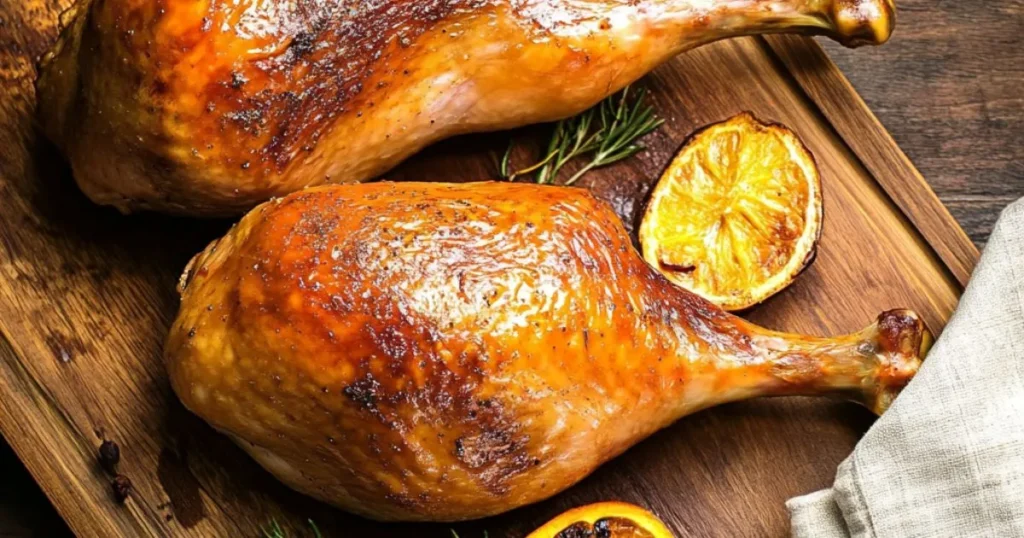Introduction to Turkey Cuts
When preparing a turkey dish, one common question arises: What are the differences between turkey drumsticks vs. turkey legs? While the terms are often used interchangeably, they actually refer to different parts of the bird. Understanding this distinction can help you choose the right cut for your recipes and achieve the best cooking results.
Turkey legs consist of both the thigh and the drumstick, offering a larger portion with a mix of textures and flavors. On the other hand, the drumstick refers only to the lower part of the leg, below the joint, known for its firm, flavorful dark meat.
These differences influence not only how you cook them but also their nutritional value and suitability for specific recipes. Let’s explore these cuts in detail.
Anatomy of a Turkey: Key Distinctions
What Defines Turkey Legs?
Turkey legs encompass a substantial portion of the bird, stretching from the joint where the thigh connects to the body down to the tip of the drumstick. This cut offers a delicious combination of dark meat with rich, savory flavors, making it a favorite among turkey enthusiasts. Whether roasted or braised, turkey legs deliver a hearty and flavorful dish.
If you’re seeking a deeper dive into specific recipes, explore this turkey drumstick recipe to see how simple ingredients can bring out the best in these cuts. Turkey legs are incredibly versatile, shining in stews, soups, or even smoked preparations.
How Do Drumsticks Differ?
Drumsticks, which are the lower part of the turkey leg, extend from the knee joint down to the ankle. Moreover, they are known for their slightly firmer texture, making them a preferred choice for various cooking methods. For instance, drumsticks are often favored for grilling, roasting, or smoking due to their rich flavor and ability to retain moisture. Additionally, they’re a classic option for handheld eating, making them especially popular at state fairs or even reminiscent of medieval-style banquets. Consequently, their versatility and robust taste ensure they remain a favorite across a wide range of occasions.
Key Points to Remember:
- Turkey legs include the entire upper and lower leg sections.
- Drumsticks are the lower portion of the turkey leg, below the knee joint.
Cooking Turkey Legs vs. Turkey Drumsticks
Why Choose Turkey Legs?
Turkey legs are versatile and ideal for recipes that benefit from slow, moist cooking methods. Some examples include:
- Braising: Perfect for stews or casseroles.
- Smoking: Imparts a rich, smoky flavor.
- Roasting: Ensures tender meat with crispy skin.
Cooking Tips for Drumsticks
Drumsticks, on the other hand, excel in dishes that highlight their robust flavor and unique texture. Consider these cooking techniques:
- Grilling: Adds a delightful char and smoky aroma.
- Roasting: Enhances the drumstick’s natural juices.
- Frying: Delivers a crispy outer layer with a juicy center.
Side-by-Side Comparison:
- Turkey Legs: Best for slow-cooked or hearty meals.
- Drumsticks: Ideal for handheld dishes and grilling.
Savory Herb-Roasted Turkey Legs
Turkey legs are flavorful, tender, and perfect for a hearty meal. This recipe uses simple herbs and spices to create a delicious dish that’s easy to prepare and perfect for any occasion.

Ingredients:
- 2 large turkey legs (about 1.5-2 lbs each)
- 3 tablespoons olive oil
- 1 tablespoon unsalted butter (optional, for extra richness)
- 3 cloves garlic, minced
- 1 teaspoon salt (adjust to taste)
- 1 teaspoon black pepper
- 1 tablespoon paprika
- 1 teaspoon dried thyme
- 1 teaspoon dried rosemary
- 1 teaspoon dried oregano
- ½ teaspoon ground sage
- 1 lemon, sliced
- ½ cup chicken broth or water
Instructions:
- Prepare the Turkey Legs:
- Preheat your oven to 375°F (190°C).
- Pat the turkey legs dry with paper towels. Dry skin helps the legs crisp up in the oven.
- Season the Legs:
- In a small bowl, mix olive oil, garlic, salt, black pepper, paprika, thyme, rosemary, oregano, and sage.
- Rub the seasoning mixture generously over the turkey legs, ensuring all sides are coated evenly.
- Optional Step:
- If using butter, melt it and drizzle it over the turkey legs for added moisture and flavor.
- Arrange in Baking Dish:
- Place the turkey legs in a baking dish. Add the lemon slices around the legs for a zesty aroma.
- Pour chicken broth or water into the bottom of the dish to prevent drying out and keep the turkey juicy.
- Roast the Turkey Legs:
- Cover the baking dish loosely with aluminum foil and roast in the oven for 45 minutes.
- Remove the foil and roast for an additional 30-40 minutes, basting the legs with the pan juices every 15 minutes.
- Check for Doneness:
- Use a meat thermometer to ensure the turkey legs are fully cooked. The internal temperature should reach 165°F (74°C) at the thickest part of the meat, away from the bone.
- Rest and Serve:
- Remove the turkey legs from the oven and let them rest for 10 minutes before serving. Resting allows the juices to redistribute, making the meat tender and flavorful.
Serving Suggestions:
- Pair with roasted vegetables, mashed potatoes, or a fresh green salad.
- Drizzle the pan juices over the turkey legs for added flavor.
Nutritional Comparison between Turkey Legs vs. Turkey Drumsticks
Protein Powerhouses
Both turkey drumsticks and legs are packed with protein, but there are slight differences in their macronutrient profiles. For every 100 grams:
- Drumsticks typically contain 28 grams of protein.
- Full turkey legs average around 26 grams of protein.
Fat and Calories
- Drumsticks may have a higher fat content due to their dense muscle structure.
- Turkey legs, when including the thigh, often contain a slightly lower fat percentage overall.
Key Nutrients to Note:
- Iron: Higher in turkey legs.
- Zinc: Abundant in both cuts, essential for immune health.
Cost and Availability of Turkey Cuts
Seasonal Demand
During the holidays, turkey legs are a sought-after choice for festive meals, thanks to their generous portions and rich, flavorful meat. They are often featured in traditional dishes like roasted turkey or slow-cooked stews, making them a centerpiece for celebratory feasts. Their size and combination of thigh and drumstick make them ideal for large gatherings, providing both versatility and abundance.
Drumsticks, on the other hand, enjoy year-round popularity due to their accessibility and suitability for everyday recipes. Whether grilled, roasted, or smoked, their bold flavor and convenient size make them a favorite for casual meals. Drumsticks are also more affordable compared to full turkey legs, making them a practical choice for families and home cooks looking for cost-effective options. Their availability across seasons ensures they remain a staple in kitchens, perfect for quick weeknight dinners or outdoor barbecues, no matter the time of year.
Drumsticks are usually more affordable, making them an excellent choice for families on a budget. Turkey legs, being larger cuts, might cost more but provide ample servings for group meals.
Turkey Drumsticks and Legs in Cultural Cuisine
Global Traditions
urkey legs have been cherished in cuisines across the globe for centuries. In the United States, they hold a special place as a highlight of Thanksgiving dinners, symbolizing family gatherings and gratitude. Their rich, savory flavor and hearty portion make them a centerpiece of festive tables, paired with traditional sides like stuffing and cranberry sauce.
In European medieval feasts, turkey legs, or similar large poultry legs, were a symbol of abundance and festivity. Often featured in banquet halls, they were enjoyed by nobility and commoners alike, evoking images of grand feasts with overflowing platters. Their size and robust flavor made them a favored choice for celebrations, embodying prosperity and communal joy.
Whether in modern holiday meals or historical feasts, turkey legs continue to be a timeless favorite, connecting people through tradition and the universal love of delicious, hearty food.
Modern Favorites
Drumsticks have become a favorite in modern cuisine, celebrated for their versatility and bold flavor. From smoky barbecues to elegant gourmet-style plated dishes, they adapt effortlessly to a variety of cooking styles and occasions. Their handheld nature makes them particularly appealing for casual gatherings, where they offer a convenient and satisfying option for guests.
Perfect for outdoor events like picnics or backyard parties, drumsticks are often grilled, roasted, or fried, delivering a crispy exterior and juicy interior that everyone loves. Their rich, dark meat provides a hearty, flavorful experience that pairs well with a wide range of seasonings and sauces. Whether enjoyed as a fun snack or a key component of a main course, drumsticks continue to win hearts in kitchens and at dining tables around the world.
Conclusion
So, are turkey drumsticks the same as turkey legs? Not quite. While drumsticks are a portion of the turkey leg, they differ in texture, flavor, and culinary applications. The drumstick is the lower section of the leg, known for its dark meat and rich taste, perfect for grilling or roasting. Meanwhile, a turkey leg includes both the drumstick and the thigh, offering a mix of tender and robust textures.
Understanding these differences ensures you choose the best cut for your recipe, whether crafting a comforting stew or a flavorful barbecue dish. Next time you’re shopping, keep their unique qualities in mind for the perfect meal.
<h2><strong>FAQs about Turkey Legs vs. Turkey Drumsticks
1. What do you call a turkey leg?
A turkey leg refers to the entire leg portion of the bird, which includes both the thigh (upper part) and the drumstick (lower part). It’s a popular cut of turkey, known for its rich, dark meat and robust flavor, often used in hearty dishes.
2. What part of the turkey is the drumstick?
The drumstick is the lower portion of the turkey leg, extending from the knee joint down to the ankle. It is a firm, meaty section known for its tender, flavorful dark meat, commonly used for roasting, grilling, or handheld dishes.
3. What is the turkey leg at Disney made of?
The turkey legs served at Disney theme parks are jumbo-sized drumsticks, typically from larger turkeys. Their smoky flavor and hefty size make them a crowd favorite, giving them a medieval-style appeal.
4. Why are legs called drumsticks?
The term “drumstick” comes from the resemblance of this cut of meat to the shape of a drumstick used by drummers. Its elongated, cylindrical shape with a wider end mirrors the tool, giving it its iconic name.

